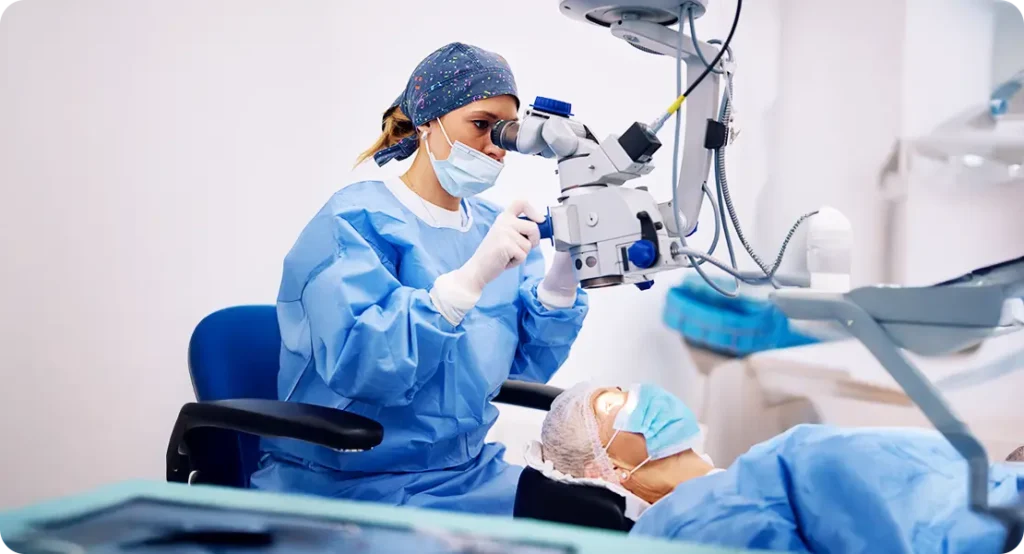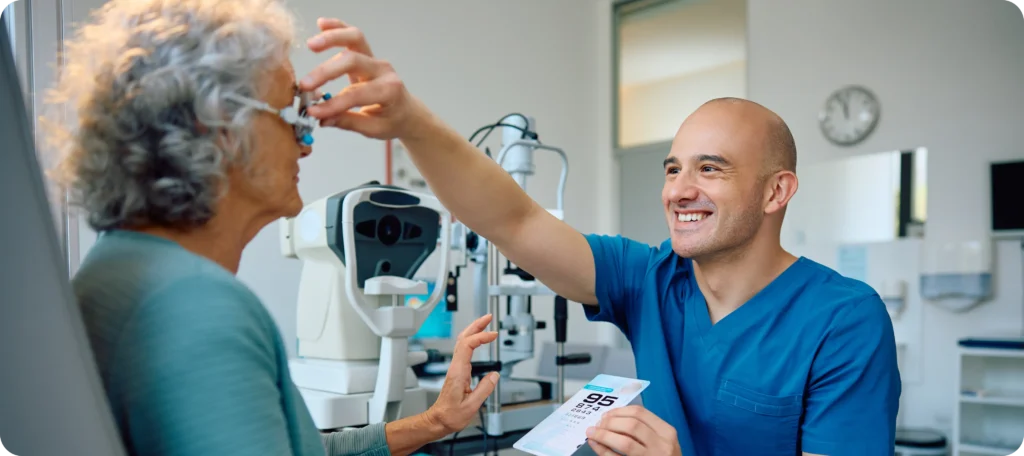So, you’ve had cataract surgery, and at first everything seemed clear and bright. But now, weeks or maybe even months later, your vision is getting cloudy again. Sound familiar? You’re definitely not alone. This is actually a pretty common experience, and the good news is there’s a quick and effective solution: a YAG capsulotomy.
But once the laser treatment is booked in, the next big question is—what happens after? What can you expect during recovery? And how can you make sure you’re well prepared? That’s exactly what we’ll cover in this guide. Whether you’ve already got your appointment scheduled or are just starting to explore your options, this is your go-to roadmap for life after YAG capsulotomy.
Understanding What a YAG Capsulotomy Actually Does
Before we dive into recovery, it’s worth taking a moment to explain exactly what this procedure is and why it’s needed in the first place. After cataract surgery, many people enjoy clearer vision for months or even years. However, it’s not uncommon for that clarity to gradually diminish again. This isn’t because the artificial lens implanted during cataract surgery has failed—it’s due to a natural process called posterior capsule opacification (PCO). Essentially, a thin layer of cells begins to grow on the back part of the lens capsule, the membrane that originally held your eye’s natural lens. Over time, this growth scatters light as it enters the eye, causing vision to appear cloudy, hazy or dim.

PCO is often referred to as a “secondary cataract”, even though it’s not a true cataract in the traditional sense. It doesn’t affect the artificial lens itself but rather the clear capsule surrounding it. The symptoms can be quite similar to those you experienced before your initial cataract surgery—blurred or foggy vision, difficulty reading, trouble seeing in bright light, or glare from headlights at night. Understandably, it can be frustrating to experience these symptoms again after you’ve already gone through eye surgery. But the good news is that treating PCO is far simpler and quicker than the original cataract operation.
That’s where YAG laser capsulotomy comes in. This quick and painless outpatient procedure involves using a precise laser beam to make a small opening in the cloudy posterior capsule. This opening allows light to pass through unimpeded, instantly clearing up the visual distortion caused by the cell build-up. The laser is highly focused and only targets the capsule itself—there’s no cutting or removal of tissue involved. Most patients describe the procedure as completely painless, and it usually only takes about five minutes to perform.
Because it’s non-invasive and requires no stitches or sedation, you’re typically in and out of the clinic within an hour. There’s no need for a hospital stay, and you can return home the same day. It’s remarkable how such a small change inside the eye can restore such a large improvement in vision. Once the procedure is done, most people notice clearer vision within hours, though for some it may take a day or two for their eyesight to fully sharpen. Now that we’ve covered what YAG capsulotomy does and why it’s needed, let’s talk about what happens after—and how you can ensure the recovery goes as smoothly as possible.
What to Expect Immediately After the Procedure
The procedure might be quick, but that doesn’t mean you’ll walk out seeing perfectly right away. For most people, the first few hours after treatment can feel a bit strange.
You’ll likely have some blurry or hazy vision, which can be caused by the dilation drops used during the procedure, or from light scatter immediately after the laser is used. This typically settles within a few hours as your pupils return to their normal size.
You may also notice little floaters—tiny specks or cobweb-like shapes drifting across your vision. These are common and usually temporary, but they can be a bit annoying at first. They tend to fade as the eye heals and the debris from the laser procedure settles or is absorbed.

The First 24 Hours: Rest and Observation
For the first day after your YAG capsulotomy, the main thing is to take it easy. There’s no need to lock yourself indoors, but it’s wise to avoid strenuous activity, especially anything that involves heavy lifting or bending over. These actions can increase pressure in the eye, which you want to avoid in the early stages of healing.
Your vision may fluctuate during this time. Some people notice an almost immediate improvement, while others find their eyesight continues to sharpen over several days. Both experiences are normal.
You may be prescribed anti-inflammatory eye drops to use for a few days after the treatment. These help prevent inflammation and keep the healing process on track. Make sure to use them exactly as advised by your ophthalmologist.
Day Two to Day Five: Gradual Visual Improvement
Most people see a steady improvement in their vision over the next few days. You might go from cloudy or blurry vision to sharp and clear within just 48 hours. Others may take slightly longer—but rest assured, progress is the goal, and it usually happens without any issues.
At this stage, floaters may still be present, especially if they were noticeable right after the procedure. While they can be bothersome, they’re usually not dangerous and tend to diminish with time.
You should avoid rubbing your eyes during this time, even if they feel slightly irritated or itchy. This can interfere with the healing process and potentially introduce bacteria into the eye, increasing the risk of infection.
End of Week One: Settling In and Follow-Up
By the end of the first week, you’ll likely notice a clear difference in your vision compared to before the YAG capsulotomy. Many people describe the change as “life-changing” or say it feels like they’ve just had their cataract surgery all over again.
Your ophthalmologist will probably schedule a follow-up appointment within a week or two. This is to check how well the eye is healing and confirm that your intraocular pressure (IOP) is within the normal range. It’s an important check, as a small number of people may experience a temporary spike in IOP after the procedure.

If you do have high pressure, your doctor may prescribe eye drops to bring it down and will monitor you closely until it stabilises.
Common Side Effects and How to Handle Them
Like any medical procedure, YAG capsulotomy comes with a few potential side effects, though most are mild and short-lived. Still, it’s good to be prepared:
- Floaters: We’ve already mentioned these, but it’s worth repeating. Floaters are incredibly common after the laser treatment and usually settle down on their own. If they increase suddenly or you see flashing lights, contact your eye doctor straight away.
- Mild Eye Discomfort: You might feel a slight grittiness or dryness in the treated eye. Artificial tears can help, and the sensation usually fades within a day or two.
- Light Sensitivity: Your eyes may be more sensitive to bright light for a short time. Sunglasses can make a big difference while you’re out and about, especially if the weather is sunny.
- Temporary Vision Disturbances: Some people experience glare, halos around lights, or slightly distorted vision immediately following the treatment. These effects tend to fade as the eye settles and the laser opening becomes more stable.
How to Prepare for a Smooth Recovery
Preparation makes all the difference when it comes to a speedy and stress-free recovery. Here’s how you can set yourself up for success:
- Arrange Transport: You won’t be able to drive yourself home after the procedure. Your vision will be temporarily blurred, and your pupils will still be dilated. So make sure you have someone ready to take you home afterwards.
- Keep the Day Free: Although the actual procedure is quick, it’s best not to schedule anything else on the same day. Give your eyes and your body time to rest.
- Stock Up on Essentials: Make sure you have your prescribed eye drops ready, along with over-the-counter lubricating drops if needed. A good pair of sunglasses will also help with light sensitivity.
- Avoid Straining Activities: Heavy lifting, intense exercise, and bending over should be avoided for at least a couple of days post-procedure. Take it easy and allow your eye the time it needs to recover.
What About Work and Daily Activities?
One of the best things about YAG capsulotomy is that the recovery is generally quick and doesn’t require weeks off work. Many people are back at their desks or resuming their normal activities within a day or two.
That said, everyone’s recovery is unique. If your job involves physical labour, or if your vision is still settling, you might want to give yourself a bit more time. Listen to your body—and your eyes!
For those who work on screens, just be aware that your vision might still fluctuate slightly during the first few days. Make sure your workspace is well-lit and take regular breaks to reduce eye strain.

When to Contact Your Doctor
Most people sail through recovery with no issues at all. But it’s important to know the warning signs that something might be amiss:
- Sudden or severe eye pain
- Rapid increase in floaters or flashing lights
- Significant drop in vision after initial improvement
- Signs of infection like redness, discharge, or swelling
If you experience any of these, don’t wait—contact your eye specialist immediately.
Long-Term Outlook After YAG Capsulotomy
The results from a YAG capsulotomy are typically permanent. Once that cloudy capsule has been opened, it doesn’t tend to become opaque again. That means your improved vision should be here to stay.
The laser opening remains in the capsule indefinitely, and you won’t need to repeat the procedure in the future. However, some people may still develop other age-related eye conditions over time—so routine eye checks remain important.
Frequently Asked Questions
Will my prescription change after the procedure?
It might—especially if your vision had become significantly blurred due to posterior capsule opacification (PCO) before the laser treatment. When the back of the lens capsule clouds over, it distorts how light enters the eye, affecting clarity and focus. As a result, your current glasses or contact lens prescription may have been compensating for this blur, rather than accurately reflecting your underlying visual needs.
Once the YAG capsulotomy clears the capsule and your vision sharpens, you may find that your existing prescription no longer feels quite right. Some people report better unaided vision than before, while others feel their lenses are either too strong or not quite balanced. It’s a bit like wiping a fogged-up lens—suddenly everything looks different, and your eyes need time to adapt to the change.
It’s generally recommended to wait a couple of weeks after the procedure before scheduling a new eye test. This gives your vision time to stabilise and ensures your prescription is based on your true, post-treatment visual clarity. Your optometrist will be able to assess your needs accurately and guide you through any updates required, whether it’s a subtle tweak or a more noticeable change.
Can both eyes be treated on the same day?
In most cases, YAG capsulotomy is done one eye at a time, even if both eyes are affected by capsule opacification. The main reason for this approach is to ensure a safer and more controlled recovery process. By treating one eye first, the ophthalmologist can monitor how your vision responds to the laser and whether any side effects arise before proceeding with the second eye.
Treating both eyes on the same day could leave you with temporary vision instability in both eyes at once, especially during the first few hours when floaters or light sensitivity are most noticeable. This can make tasks like walking, reading, or even navigating your home more challenging. Splitting the procedures gives your brain and eyes time to adjust, ensuring that your overall visual experience is not disrupted too drastically.
Most specialists recommend waiting at least a week or two between treating each eye. This break allows the first eye to settle and provides a chance to assess visual improvements. If all goes well and you’re comfortable with the results, the second eye can then be scheduled with confidence. It’s a cautious but patient-friendly approach that prioritises both comfort and safety.
Is there any risk of retinal detachment?
The risk of retinal detachment following a YAG capsulotomy is very low, but it’s not entirely zero. The procedure involves using a focused laser to create an opening in the lens capsule, and in rare cases, this may lead to changes in the eye’s vitreous gel or exert slight traction on the retina. This is more likely in people who are highly myopic (short-sighted) or have pre-existing retinal issues.
That said, millions of YAG capsulotomies are performed safely each year with no complications. Ophthalmologists are trained to screen for risk factors before the procedure, and they use the minimum laser energy necessary to achieve the desired result. Post-procedure follow-ups are also designed to catch any unusual changes early, which adds an extra layer of protection.
What’s important is knowing the warning signs. If you notice sudden flashes of light, an increase in floaters, or a shadow or curtain effect across your field of vision, you should seek immediate medical attention. These could be early signs of retinal detachment, and prompt treatment can prevent permanent damage. While it’s rare, staying alert and acting quickly can make all the difference.
Final Thoughts: A Small Procedure With Big Results
YAG capsulotomy might be one of the simplest eye procedures out there, but its impact on your vision can be massive. If you’ve been struggling with cloudiness after cataract surgery, this quick laser treatment can genuinely bring your world back into focus.
The recovery is usually straightforward, but taking the time to prepare and knowing what to expect can really make a difference. Whether it’s resting up for the first 24 hours, being patient with floaters, or following your doctor’s advice to the letter, you’ll be giving your eyes the best possible chance to heal beautifully.
So if you’re heading in for a YAG capsulotomy soon, you can breathe easy. With a little care and attention, you’ll be back to seeing the world in crisp, clear detail in no time. If you’re concerned about cataracts or would like to learn more about YAG Laser Capsulotomy, feel free to contact us at the London Cataract Centre—we’re always happy to help.

